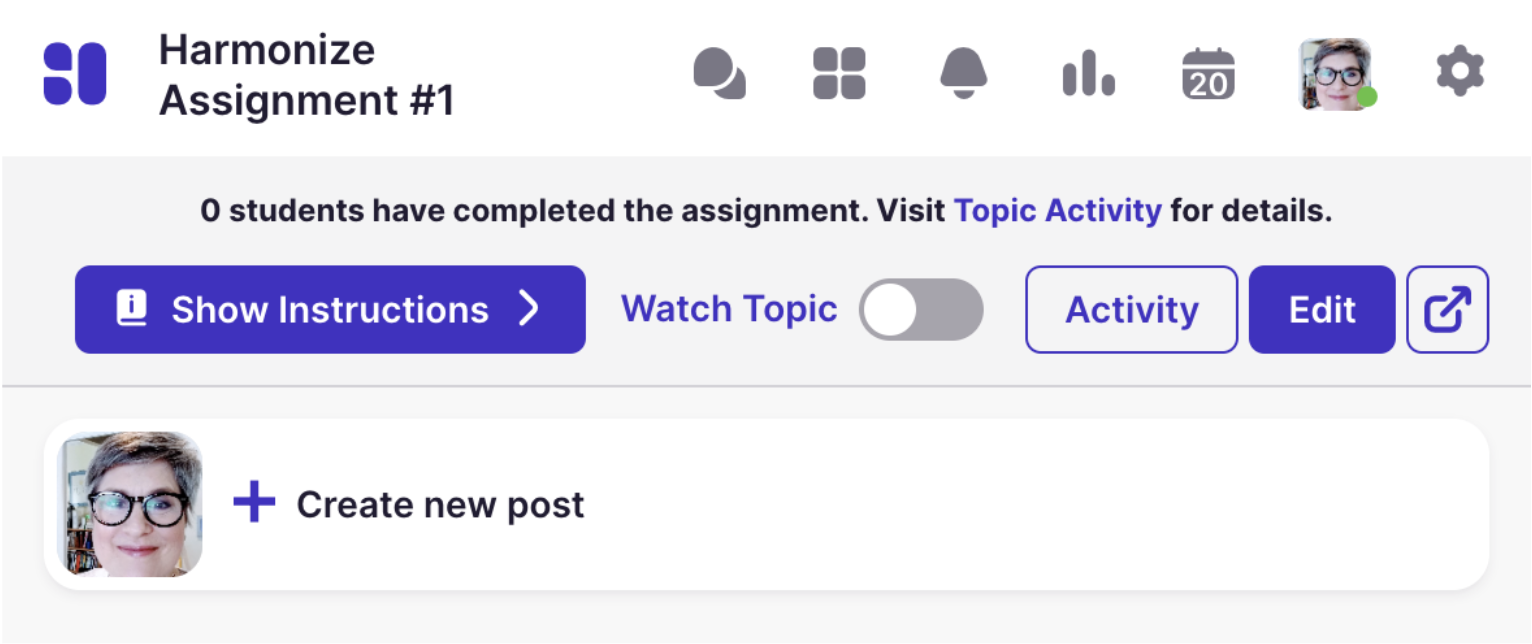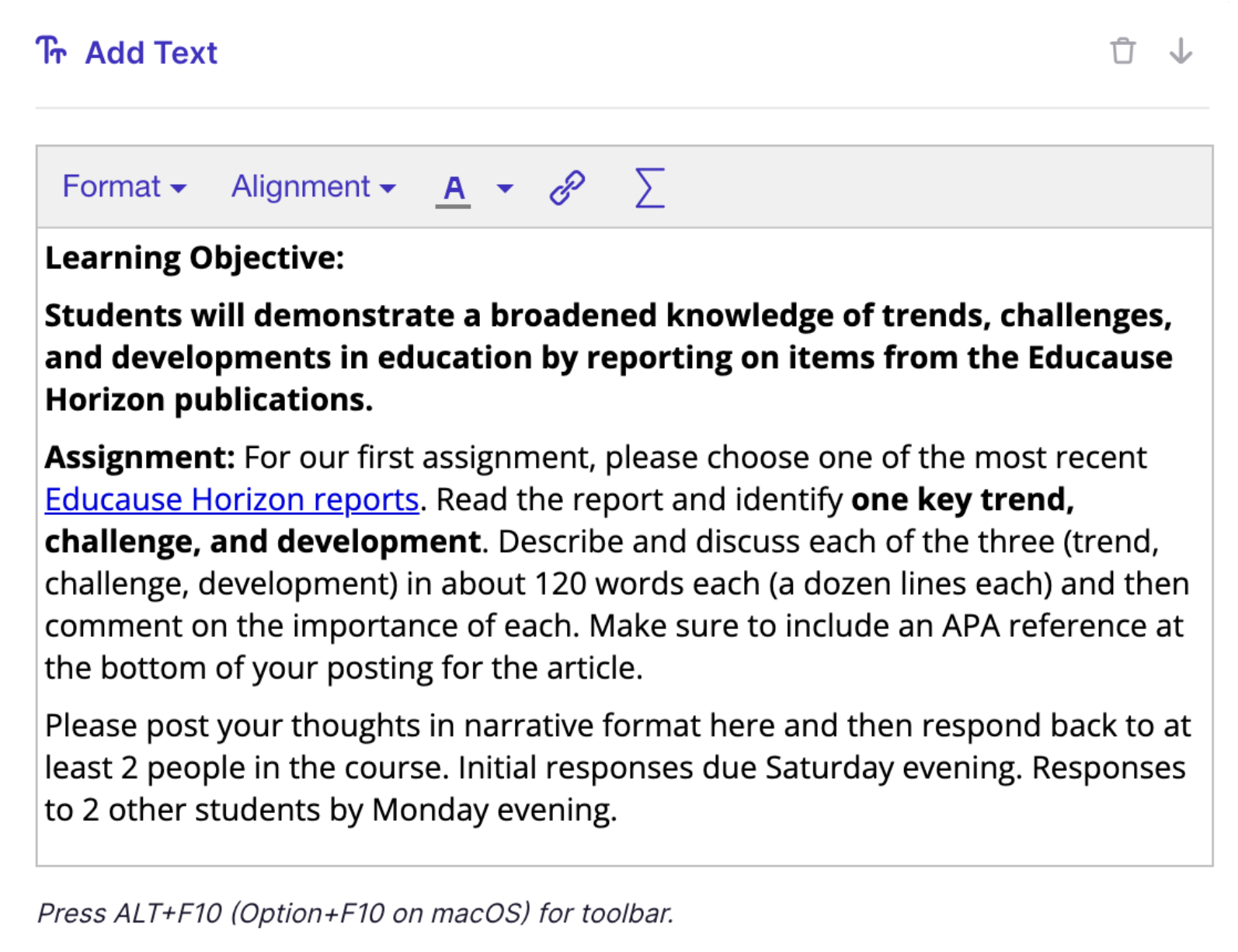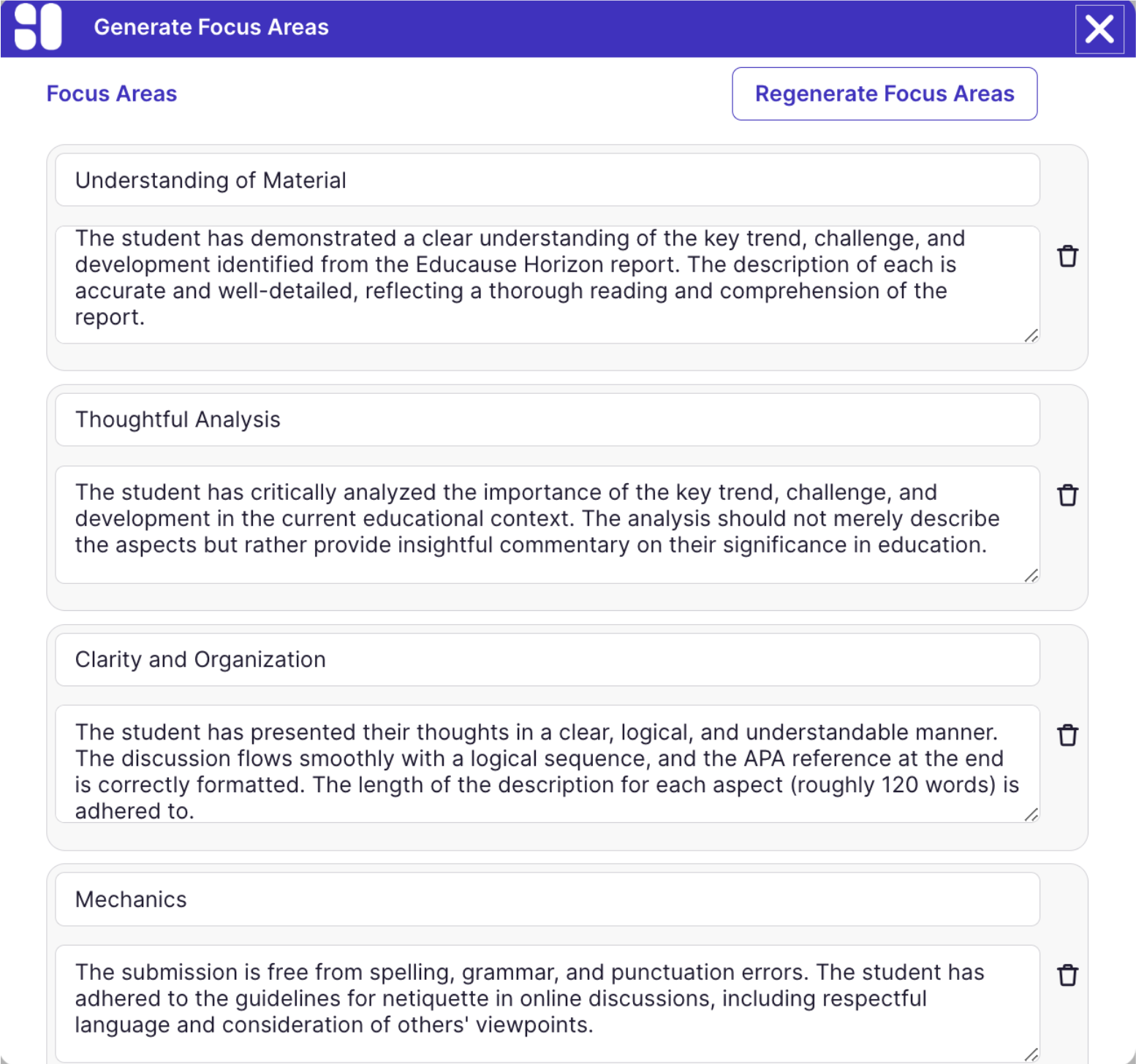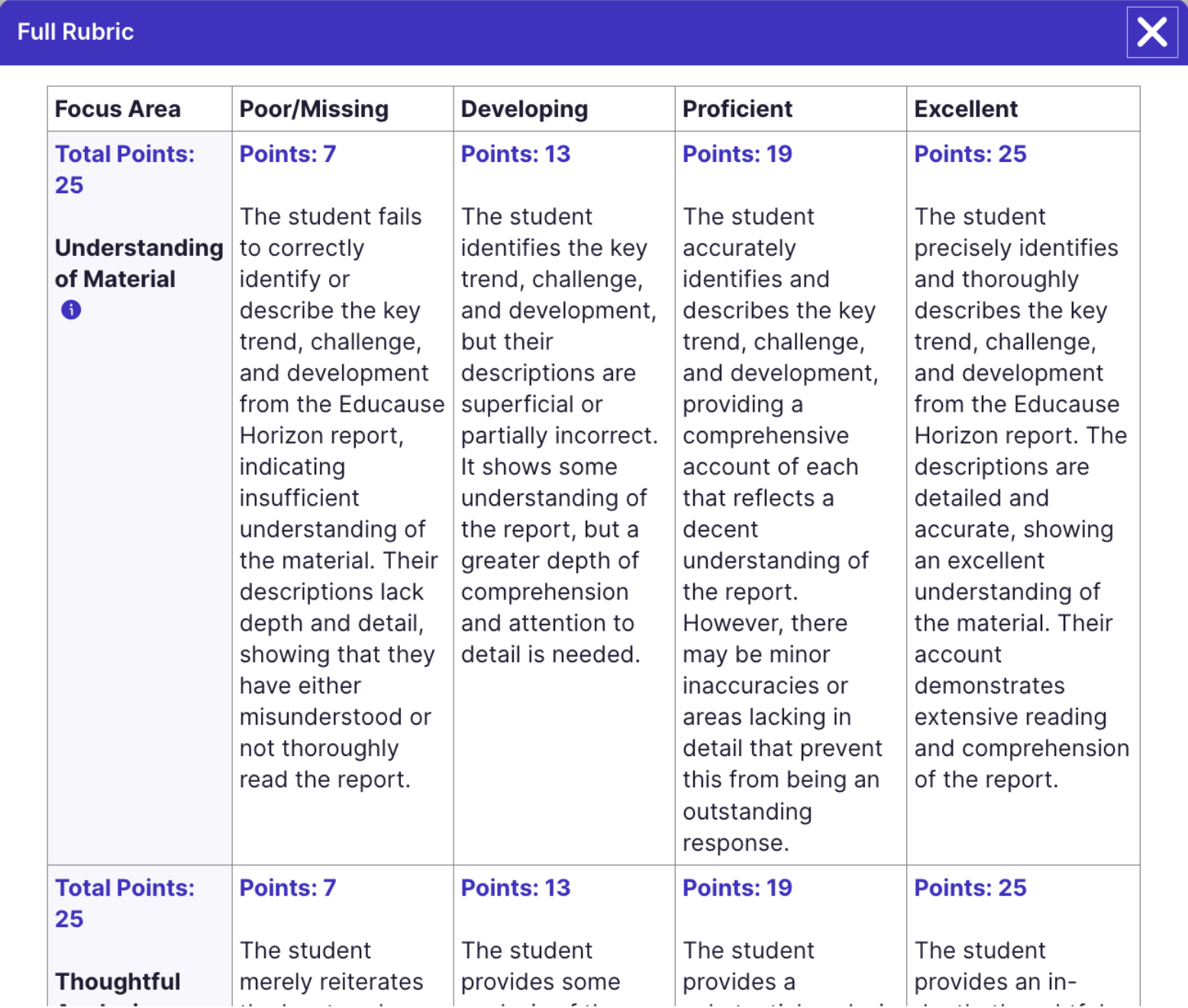According to a study conducted by researchers at Grand Canyon University in 2013 (pdf), “full-time online faculty reported spending the majority of their time on two teaching tasks: grading papers and assignments (36.93% of weekly time) and facilitating discussion threads (14.73% of instructional time).” We recognize the hard work and effort instructors spend on giving their students meaningful feedback, but we also recognize the need to streamline the grading process so your time can be spent elsewhere. While not appropriate for all assignments, rubrics–when designed well–can save you grading time and are a great tool to assess your students’ work.
What are rubrics?
Rubrics are tools that “describe the rules that guide [instructors’] evaluation of their students’ work or performance” by “add[ing] reliability, validity and transparency to assessments” (Chowdhury [pdf], 2018). While rubrics are not useful in all situations (a multiple choice exam, for instance), when it comes to performance-based tasks (writing, oral presentations, projects, etc.), rubrics can be extremely valuable for both students and instructors. Rubrics generally fall into three categories: analytic, holistic, and checklist.
Analytic rubrics
When you think of the typical “rubric,” the analytic rubric is probably the kind of rubric you picture in your mind. These rubrics “resemble a grid with the criteria [categories for grading] for a student product listed in the leftmost column and with levels of performance [scores or markers of success] listed across the top row often using numbers and/or descriptive tags” (DePaul University). Analytic rubrics are especially useful for students, because a task is broken down into specific categories with a range of performance levels. Students can focus on specific skills when working on their assignments, and they know exactly what to work on once they receive feedback from their instructor using this kind of rubric.
Analytic rubrics also demonstrate a level of nuance. Unlike other rubrics which might take an “all or nothing” approach, analytic rubrics can reward students for the things they’re doing well, even if they aren’t yet at mastery of a particular skill or concept. While this all sounds great (and it is!), an analytic rubric is not appropriate in all circumstances. If the levels of performance aren’t very well defined, then the rubric is not a reliable tool. For some assignments, it may be more appropriate to look at other rubric types.
Developmental rubrics are a “subset of analytic trait rubrics” that are “designed to answer the question, ‘to what extent are students who engage in our programs/services developing this skill/ability/value/etc.’” (DePaul University)? These rubrics are often based on theories of development and may not be immediately helpful in higher education courses. However, if you work with students who may have a career working with children or teenagers, providing them opportunities to develop these kinds of rubrics could prove useful.
Analytic rubric example: 4 point discussion rubric from Carrie Levin
| Criteria | Meets Expectations (1 point) | Developing (0.5 points) | Below Expectations (0.25 points) | No Post (0 points) |
|---|---|---|---|---|
| Initial post – Original thought or contribution | Well-developed ideas, including introduction of new ideas; stimulates discussion. No mechanical issues. | Ideas are mostly well-developed, but new ideas are not introduced into the discussion or ideas do not stimulate discussion. Mechanical issues may exist. | Partially developed ideas; sometimes stimulates discussion. Mechanical issues exist. | No post |
| Initial post – Development of thought | Clear evidence of critical thinking – application, analysis, synthesis, and evaluation of topic content. Posting is characterized by clarity of argument, depth of insight into issues, originality of treatment, and relevance to course content. Posting provides clear references to assigned readings and articulate responses to discussion questions, sometimes including unusual insights. | Some critical thinking is evident, but could be improved with more application, analysis, synthesis, and evaluation of topic content. Posting tends to address peripheral issues. Could be improved with stronger analysis and more creative thought, such as in-depth critique and application of assigned readings. Some references to assigned readings made, but overall, questions are addressed indirectly | Little evidence of critical thinking; could be improved with application, analysis, synthesis, and evaluation of topic content. Posting needs more analysis and creative thought, such as in-depth critique and application of assigned readings. | No post |
| Response #1 | Response posting is well-developed and provides clear evidence of critical thinking with no mechanical problems. | Response posting needs additional development and/or does not provide clear evidence of critical thinking. Mechanical problems exist. | Response posting provides little content beyond agreeing with initial posting. | No response |
| Response #2 | Response posting is well-developed and provides clear evidence of critical thinking with no mechanical problems. | Response posting needs additional development and/or does not provide clear evidence of critical thinking. Mechanical problems exist. | Response posting provides little content beyond agreeing with initial posting. | No response |
Holistic rubrics
Holistic rubrics “consist of a single scale with all criteria to be included in evaluation being considered together (e.g., clarity, organization, and mechanics)” (DePaul University). Holistic rubrics are easier to create and, with proper rater training, can be very reliable tools. Grading an assignment with a holistic rubric is generally a very fast process, as you are looking at the product as a whole as opposed to evaluating each aspect of the product.
These kinds of rubrics are especially valuable for assignments like reflections. Typically, in these kinds of assignments, we’re looking for students to share their thoughts and ideas, but there aren’t as many nuances in the levels of performance. A holistic rubric would allow an instructor to quickly share what aspects of the reflection are most important, giving students the freedom to tackle the assignment in a way that suits their learning styles best while still meeting the given requirements.
While holistic rubrics can be a great tool, it is important to keep the descriptors short. A good rule of thumb is to be able to describe the levels of performance in 1-3 sentences. If you find yourself needing to write more to convey what you want from students, an analytic rubric might be a better choice.
Holistic rubric example: DePaul University
- Above Average (4 points): The audience is able to easily identify the focus of the work and is engaged by its clear focus and relevant details. Information is presented logically and naturally. There are no more than two mechanical errors or misspelled words to distract the reader.
- Sufficient (3 points): The audience is easily able to identify the focus of the students work which is supported by relevant ideas and supporting details. Information is presented in a logical manner that is easily followed. There is minimal interruption to the work due to the misspellings and/or mechanical errors.
- Developing (2 points): The audience can identify the central purpose of the student work without little difficulty and supporting ideas are present and clear. The information is presented in an orderly fashion that can be followed with little difficulty. There are some misspellings and/or mechanical errors, but they do not seriously distract from the work.
- Needs Improvement (1 point): The audience cannot clearly or easily identify the central ideas or purpose of the student work. Information is presented in a disorganized fashion causing the audience to have difficulty following the author’s ideas. There are many misspellings and/or mechanical errors that negatively affect the audience’s ability to read the work.
Checklist rubrics
Unlike the other rubrics discussed here, checklist rubrics feature “only two levels of performance” (DePaul University). These kinds of rubrics take an “all or nothing” approach to evaluation; either the product has what you’re looking for, or it doesn’t. Checklist rubrics might be longer than other rubrics due to the number of criteria, but if written well, using a checklist rubric might be a quick way to assess student work.
Checklist rubrics can be especially helpful in assessing work in fields like mathematics. If you want students to provide the correct answer to a problem, show their work, and explain their steps, you can create a checklist with those criteria and award points for each component that is present in their product. They are less helpful in assignments that have nuanced criteria or distinct and varied levels of performance.
Rubrics do not need to be used to assign grades. Checklist rubrics are great reflective tools for students. For example, you might provide a checklist rubric to students before they submit an essay or other written assignment, which they could use to double check their work before submitting. In these scenarios, it’s important for them to know if that rubric will also be used to evaluate their work or if it’s simply formative; with clear communication, students will find value in the opportunity to reflect before turning in assignments.
Checklist rubric example: math problem evaluation
| Criteria | Present or Not Present (1 point each) |
|---|---|
| The student arrives at the correct answer. | [insert check if yes, 0 if no] |
| The student shows their work for how they arrived at their answer. | [insert check if yes, 0 if no] |
| The student explains their process using course principles. | [insert check if yes, 0 if no] |
Benefits of using rubrics
Developing a rubric can be a daunting task, and it can be easy to fall into the trap of focusing primarily on the disadvantages, some of which are outlined in ION’s rubric introduction. However, it’s important to note that these disadvantages largely arise from rubrics that are not fully thought out or developed. “Plus-one thinking” is especially important in rubric development; instead of focusing on getting all of your rubrics out there at once, try adding one rubric to an upcoming assignment. By taking the time to really focus on just one rubric, you’re likely to find that there are many advantages to these tools.
Course consistency
Rubrics include information about what the point value is for an assignment (or part of an assignment), with clear descriptions of what criteria were used to evaluate the work. If done correctly, these criteria are aligned with the learning objectives for the course (or unit/module), and “[t]his alignment helps teachers gain greater clarity on both content and outcomes as they are focused on what they [want] their students to learn” (Ragupathi & Lee, 2020).
Rubrics are also linked to more objective and consistent grading practices. In a literature review from Jonsson and Svingby, they concluded that “reliable scoring of performance assessment can be enhanced by the use of rubrics, especially if they are analytic, topic-specific, and complemented with exemplars and/or rater training” (2007). Ragupathi and Lee (2020) go on to assert that this is true, “even when multiple raters are involved in evaluating student work.” When we grade without a rubric–even when we internally know what we’re looking for–we create situations where we might be grading based on a “feeling” in that moment that is hard to reproduce. Rubrics can help keep our grading practices consistent from one submission to the next, and from term to term.
Student work
Rubrics don’t just benefit our courses and the instructors who use them; students also see benefits when rubrics are utilized for assignments. When instructors use rubrics to evaluate student work, students can use that feedback to “identify what they are doing well and what they need to do to improve their academic performance and achieve their learning goals” (Pinkerton, 2022). Rubrics are a form of feedback for students that allow them to see exactly where they are performing and what steps they would need to take in order to improve. This is especially helpful when instructors use the same rubric for multiple assessments (like using a rubric for your discussions in your courses). Based on your continued use of a rubric tool, students can see their starting performance and their growth over time.
But rubrics don’t have to only be used by instructors for students to see the benefits. Ragupathi and Lee (2020) describe ways in which rubrics can be used as “scaffolds for assessment as learning.” When students have access to the rubric for assessment ahead of time (or, better yet, they co-create a rubric with you), “students can then use rubrics to plan their assessment task, clarify targets, determine and focus effort where needed, identify issues related to the task, [and] regulate the process in the effort to produce high-quality work” (Ragupathi & Lee, 2020; emphasis added). Students can do this independently, or–in a peer review process–they can do this for each other with little to no intervention from the instructor.
Lastly, rubrics can be beneficial for students of color, first generation students, non-traditional students, and struggling students. Wolf and Stevens (pdf) assert that “[i]n academic environments we often operate on unstated cultural assumptions about the expectations for student performance and behavior and presume that all students share those same understandings” (2007). Through their research, they found that these groups of students “may have been raised with a different (but valid) set of rules and assumptions about language, communication, and school performance,” but that “rubrics . . . can make learning expectations or assumptions about the tasks themselves more explicit.” To some extent, this is also true for the faculty, staff, and peers who students may turn to besides their assigned instructor for assistance. When students seek help from The Learning Hub, former instructors or teachers, or friends or student tutors, those people offering assistance also benefit from having explicit expectations outlined in a rubric. The feedback and guidance they can provide becomes more targeted, and struggling students are able to receive more direct instructions for how best to succeed.
Resources
How to Get Started
+
The first thing to do to get started is to not reinvent the wheel; there are tons of resources that exist online to help you build a rubric. For example, AAC&U has 16 VALUE rubrics(link is external) that might prove helpful as a baseline to get started. Consider tweaking these existing rubrics to meet the needs of your students and your courses.
Generative AI can also help in this regard. AI for Education has a page with different prompt suggestions for how to get ChatGPT to help you create a rubric. Like any query with ChatGPT, there will likely be editing to do on your part to completely align the rubric to learning objectives in your course, but this can reduce the amount of time needed to create the tool. If you’re a Harmonize discussion user, the ability to have ChatGPT generate a rubric for a discussion is built directly into the platform.
If you prefer to start from scratch, you’ll want to make sure that you create the rubric before assigning the task to students, and when considering what criteria to include and how many points to award, consult the learning objectives for your course, module, unit, etc., as well as your grading scale. Once you’ve created your rubric, you can add your rubric directly to Canvas(link is external), which will allow you to grade assignments using the rubric directly in SpeedGrader.
AI-Generated Rubrics in Harmonize Discussions
+
Adding a grading rubric is a simple yet powerful "plus one" strategy that can significantly elevate the quality of assessment and feedback for your courses. Rubrics provide clear guidelines, promote transparency, and streamline the grading process, ultimately empowering students to understand expectations and strive for excellence.
Creating a rubric from scratch can be a daunting task. The Harmonize discussion tool – available to all faculty members at UIS – has added a new feature that uses powerful AI technology modeled on Bloom’s taxonomy to assist in the creation of a grading rubric. It can be a good brainstorming partner for suggestion ideas and rubrics for rubrics based on your assignment language.
Instructions
- To start, open your Harmonize discussion assignment and click the Edit button:

- If you see an Authorize Canvas Extensions button at the top of the Topic Settings page, click it and follow the instructions for enabling syncing between Harmonize and your Canvas course (including rubric syncing).
- Before you can begin generating a rubric, you need to add instructions to your discussion. You can do that by adding text in the Instructions tab.

- Now, scroll down to the bottom of the instructions and click on the Generate Focus Areas button:

- A dialog will open as your topic instructions are in the background to ChatGPT to produce a set of 4 criteria called Focus Areas.
- Once this process completes, you'll be presented with 4 Focus Areas, each with a title and a description. In this view, you can edit any of the titles or descriptions, removing any you do not want by clicking the trashcan button, and even add your own Focus Areas by clicking Add Focus Area button. When you're happy with your Focus Areas, click the Next button.

- At this point you, if you do not intend to grade with a rubric but want to use the Focus Areas as guide for student work, click the Use Focus Areas Only button. If you intend to grade with a rubric, click the Generate Full Rubric button to continue with the full rubric generation:

- When you click Generate Full Rubric, Harmonize will take the Focus Areas and create 4 ratings for each focus area:

- Once each Focus Area's ratings have been generated, you'll have several options for adjusting your rubric:
- Click the Reverse Rating Order button to toggle order of the ratings.
- Click the Edit (pencil) button next to the rating labels to adjust their names.
- Click the Edit (pencil) button next to any Focus Area row to edit the text and/or the points of any of the ratings in that row.
- Click the Regenerate (cycle) button next to any Focus Area row to get updated rating text for each rating from ChatGPT (useful if you've recently changed the title or description of the Focus Area)
- If you need to make any adjustments to the Focus Areas, click the Back button to return to the previous dialog. Once you're happy with the rubric, click the Save Rubric button.
- Your Focus Areas will now be viewable in your topic instructions. Click the View Full Rubric button to view the entire rubric include descriptions for both Focus Areas and Ratings. Make any other adjustments you need to your topic settings and then click the Publish button.
- Upon publishing, the Focus Areas and full rubric will be viewable to students as part of the instructions for the discussion and the rubric will be synced to your course in Canvas and associated to the assignment.
- When you're ready to grade the discussion assignment in SpeedGrader, be sure to click the View Rubric button to expand out the rubric. See the following Canvas guide for grading with rubrics in SpeedGrader: How do I use a rubric to grade submissions in SpeedGrader?
Resources
+
- Using Rubrics to Promote Thinking and Learning by Heidi Goodrich Andrade
American Association of Colleges and Universities. (n.d.). Download the VALUE Rubrics. AAC&U. Retrieved January 30, 2024
Chowdhury, F. (2019). Application of Rubrics in the Classroom: A Vital Tool for Improvement in Assessment, Feedback and Learning. International Education Studies, 12(1), 61-68.
DePaul University. (n.d.). Types of Rubrics | Rubrics | Feedback & Grading | Teaching Guides | Teaching Commons. DePaul University. Retrieved January 30, 2024
Distol, P. (n.d.). Rubrics — AI for Education. AI for Education. Retrieved January 30, 2024
Illinois Online Network (ION). (n.d.). Rubric Introduction. University of Illinois Springfield. Retrieved January 30, 2024
Jonsson, A., & Svingby, G. (2007). The use of scoring rubrics: Reliability, validity and educational consequences. Educational Research Review, 2(2), 130-144.
Mandernach, B. J., Hudson, S. W., & Wise, S. (2013, July). Where Has the Time Gone? Faculty Activities and Time Commitments in the Online Classroom. The Journal of Educators Online, 10(2). DOI: 10.9743/JEO.2013.2.2
Metropolitan State University of Denver. (2022, November 30). Consider including students in creating rubrics. MSU Denver. Retrieved January 30, 2024
Pinkerton, A. (2022, November 22). Rubrics: Benefits for Faculty and Students. Center for Teaching and Learning. Retrieved January 30, 2024
Quality Matters. (2023). General Standard 3 - Assessment and Measurement. In Rubric Workbook: Standards for Course Design (HE) (7th ed., pp. 28-29). Quality Matters.
Ragupathi, K., & Lee, A. (2020). Beyond Fairness and Consistency in Grading: The Role of Rubrics in Higher Education. In Diversity and Inclusion in Global Higher Education: Lessons from Across Asia (pp. 73-95). Springer Nature Singapore.
Wolf, K., & Stevens, E. (2007). The Role of Rubrics in Advancing and Assessing Student Learning. The Journal of Effective Teaching, 7(1), 3-14.
